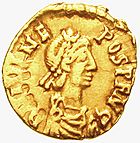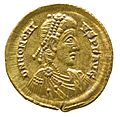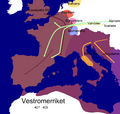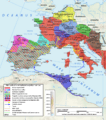Western Roman Empire facts for kids
Quick facts for kids
Roman Empire
Imperium Romanum
|
|||||||||||||||||||||||||||||||
|---|---|---|---|---|---|---|---|---|---|---|---|---|---|---|---|---|---|---|---|---|---|---|---|---|---|---|---|---|---|---|---|
| 395–476/480 | |||||||||||||||||||||||||||||||
|
|
|||||||||||||||||||||||||||||||
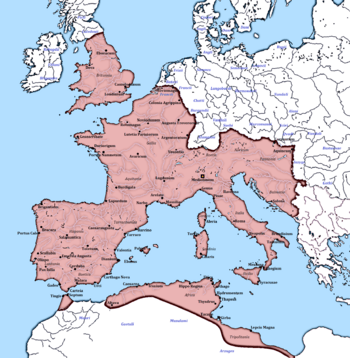
The territory controlled by the Western Roman Imperial court following the nominal division of the Roman Empire after the death of Emperor Theodosius I in AD 395.
|
|||||||||||||||||||||||||||||||
| Status | Western division of the Roman Empire |
||||||||||||||||||||||||||||||
| Capital | Mediolanum (395–402) Ravenna (402–455, 473–476) Rome (455–473) Spalatum (475–480) |
||||||||||||||||||||||||||||||
| Capital-in-exile | Spalatum (475–480) |
||||||||||||||||||||||||||||||
| Common languages | Latin (official) Regional / local languages |
||||||||||||||||||||||||||||||
| Religion | Polytheistic Roman Religion until 4th century Nicene Christianity (state church) after 380 |
||||||||||||||||||||||||||||||
| Government | Autocracy | ||||||||||||||||||||||||||||||
| Notable emperors | |||||||||||||||||||||||||||||||
|
• 395–423
|
Honorius | ||||||||||||||||||||||||||||||
|
• 457–461
|
Majorian | ||||||||||||||||||||||||||||||
|
• 474–480
|
Julius Nepos | ||||||||||||||||||||||||||||||
| Legislature | Roman Senate | ||||||||||||||||||||||||||||||
| Historical era | Late antiquity | ||||||||||||||||||||||||||||||
|
• Death of Emperor Theodosius I
|
17 January 395 | ||||||||||||||||||||||||||||||
|
• Deposition of Emperor Romulus Augustulus
|
4 September 476 | ||||||||||||||||||||||||||||||
|
• Murder of Emperor Julius Nepos
|
25 April 480 | ||||||||||||||||||||||||||||||
| Area | |||||||||||||||||||||||||||||||
| 395 | 2,000,000 km2 (770,000 sq mi) | ||||||||||||||||||||||||||||||
| Currency | Roman currency | ||||||||||||||||||||||||||||||
|
|||||||||||||||||||||||||||||||
The Western Roman Empire was the western half of the Roman Empire, from its division by Diocletian in 286 AD. The other half of the Roman Empire became known as the Eastern Roman Empire, later known as the Byzantine Empire.
The whole Roman Empire had been in difficulties since 190 AD when large Gothic tribes began moving into areas under Roman control. The leadership of Rome was weak and there was instability. Various power groups in the Roman armies kept trying to install their own Emperors, and murdering Emperors who belonged to other groups. This meant the invasions by the Germanic tribes were not successfully stopped.
The Emperor Diocletian tried to bring stability back into government by dividing the Empire into sections. These became the Western Empire which included Iberia, France, Southern Britain, Italy, North Africa and parts of Germany, and the Eastern Empire which included the Balkans, Turkey, the Levant and Egypt.
Rome ceased to be the capital from the time of the division. In 286, the capital of the Western Roman Empire became Mediolanum (modern Milan). In 402, the capital was again moved, this time to Ravenna.
The Fall of the Empire
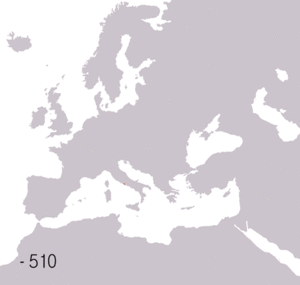
This division did not help the Western Empire which came under increasing invasions from the north from the Ostrogoths, Huns, Franks, Visigoths, and Burgundians. The armies were brought back towards Rome, abandoning England and France. The economy could not cope: the increased need for military spending caused inflation. The citizens were unhappy with rising taxes and rising prices.
In AD 398, Alaric and his Visigoths began making attacks closer and closer to the capital. By 410 he had sacked the city of Rome. In 455, the Vandals captured Rome. In 476 the Goths captured the capital.
The fall of the Western Roman Empire took place in 476 AD when the leader of the Goths, Odoacer, removed Emperor Romulus. He became King of Italy, and Roman control over the Empire in the west ended. By this time the Western Empire existed in name only, the Emperor no longer could use military, financial or political power.
Related pages
Images for kids
-
The Roman Republic before the conquests of Octavian
-
The organization of the Empire under the Tetrarchy
-
Solidus of Emperor Honorius
-
Barbarian invasions and the invasion of usurper Constantine III in the Western Roman Empire during the reign of Honorius 407–409
-
The Western Roman Empire during the reign of Majorian in 460 AD. During his four-year-long reign from 457 to 461, Majorian successfully restored Western Roman authority in Hispania and most of Gaul. Despite his accomplishments, Roman rule in the west would last less than two more decades.
-
The city of Ravenna, Western Roman capital, on the Tabula Peutingeriana, a 13th-century medieval map possibly copied from a 4th- or 5th-century Roman original
-
Map of the Eastern Roman Empire in 717 AD. Over the course of the seventh and eighth centuries, Islamic expansion had ended Roman rule in Africa and though some bastions of Roman rule remained, most of Italy was controlled by the Lombards.
-
Romance languages, languages that developed from Latin following the collapse of the Western Roman Empire, are spoken in Western Europe to this day and their extent almost reflects the continental borders of the old Empire.
-
Bust of Emperor Maximian, the first Western Roman Emperor
See also
 In Spanish: Imperio romano de Occidente para niños
In Spanish: Imperio romano de Occidente para niños


